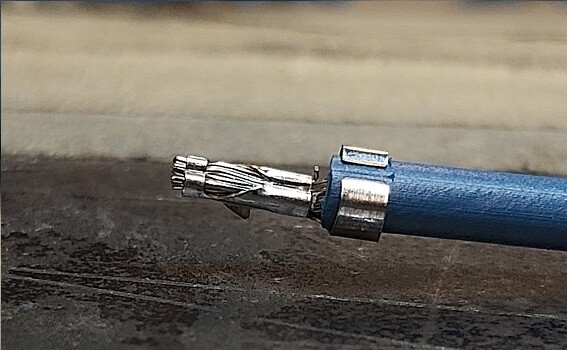Achieving a gas tight, quality crimp onto a stripped wire is always the desired result of any good wiring harness manufacturer. The best way to achieve quality is to make sure first that the wire itself is stripped properly and not missing any strands of copper that might have been removed or damages by the stripping process. Another consideration is the length of the strip and perpendicular cutting of the wire end sets up the correct situation for crimping properly. Having a well-trained, astute cutting worker means everything to the beginning of high quality parts.
Each different type of crimp terminal has a specified wire strip length that should be adhered to and is exact. These specifications are found in the crimp terminal supplier documentation for every certified part either online or hard copy book.
Hand crimping is the least desired method of crimping as the number of variables is totally reliant on human skill and tact. As well, physical wear of the tooling throughout many cycles can render crimps below minimum quality standard for certified contacts.
Press Crimping is the preferred method for limiting the variables to a reasonable level and eliminating most of the human error.
Presses must be set up by trained individuals who are well versed in crimp height measurement and knowing the manufacturer specifications for crimp height, as well as the CSA and UL pull test guidelines, which are confirmed for every set up by performing a pull test to verify the press crimping action. Wire stops or feeds on automatic equipment must be set to the correct location to ensure no insulation will be crimped under the conductor crimp area.
Further to this it may be necessary for specialty crimping such as two wires under one crimp to be tested for millivolt drop measurement across the crimp area using a special test apparatus circuit evaluation.
The Crimping Press setup is paramount to achieve high quality crimps and must be done by a professional.
Crimped wires should be inspected carefully 3 different ways to verify the manufacturing process.
1. Crimp height is measured and verified in spec to manufacturer recommendations
2. Pull test either performed as a destructive test or a pull and hold for a period of time (usually one minute) is performed to measure the force necessary to pull apart the crimp. These values are weighed against CSA & UL limits per gauge.
The non destructive hold for a minute test is just that, and then the crimped wire can be returned to the production run.
3. Visual inspection of the crimped wire should also be done by a trained press set up operator who knows what a properly crimped terminal should look like. This is especially important for “F” type crimps.
Of course it goes without saying that measurement logs should be documented in some format and kept for reference by the wire harness manufacturing quality system.
At C-T Wire Prep Inc. we perform these press setups on a daily basis as we manufacture various wiring harnesses and cable assemblies and wire leads. Any time a press has its die unlocked from the last position that was certified, it gets a brand new certified test to ensure operation.

